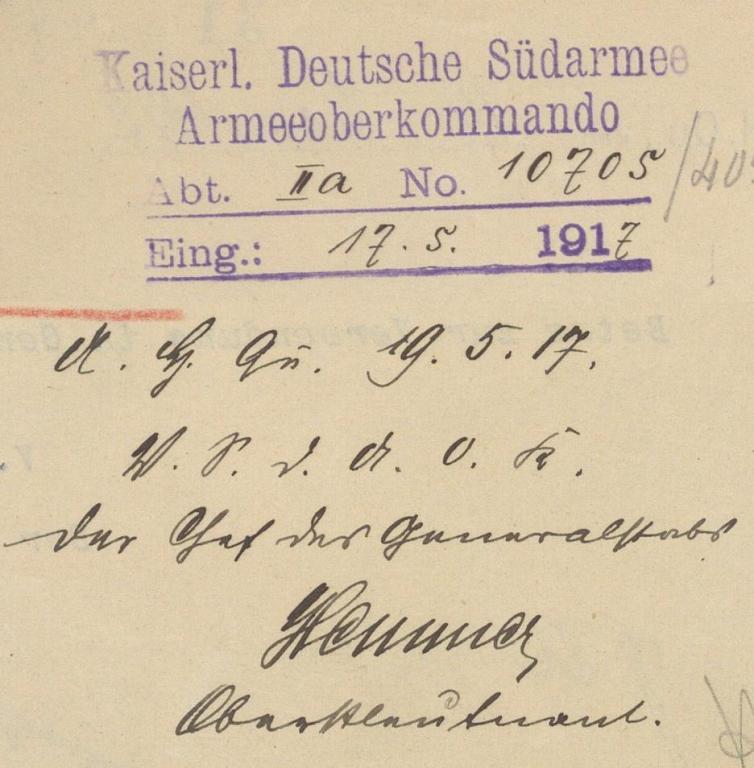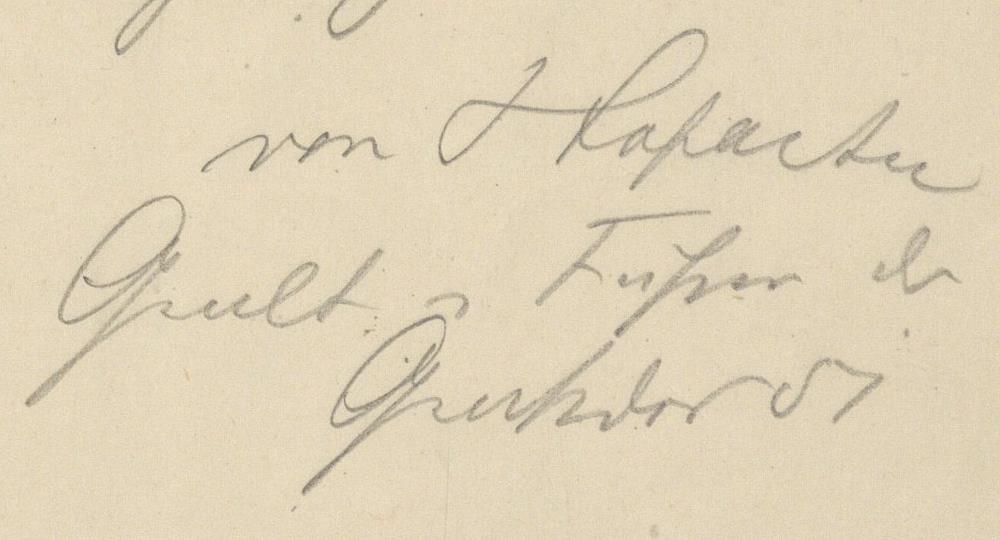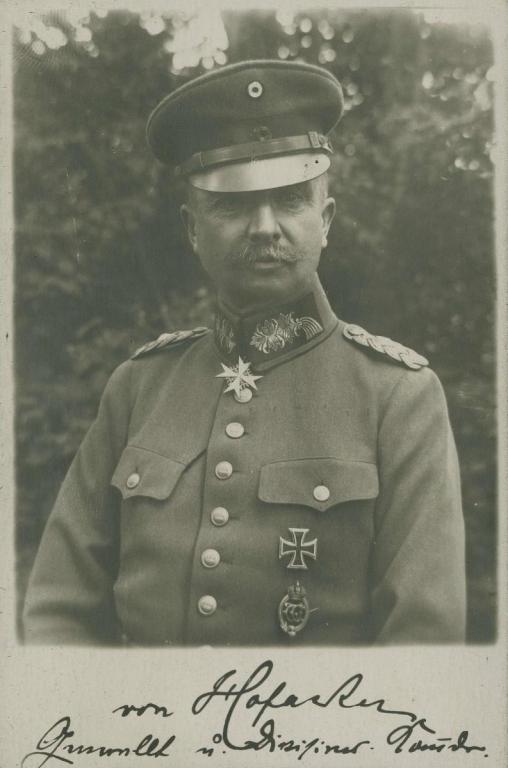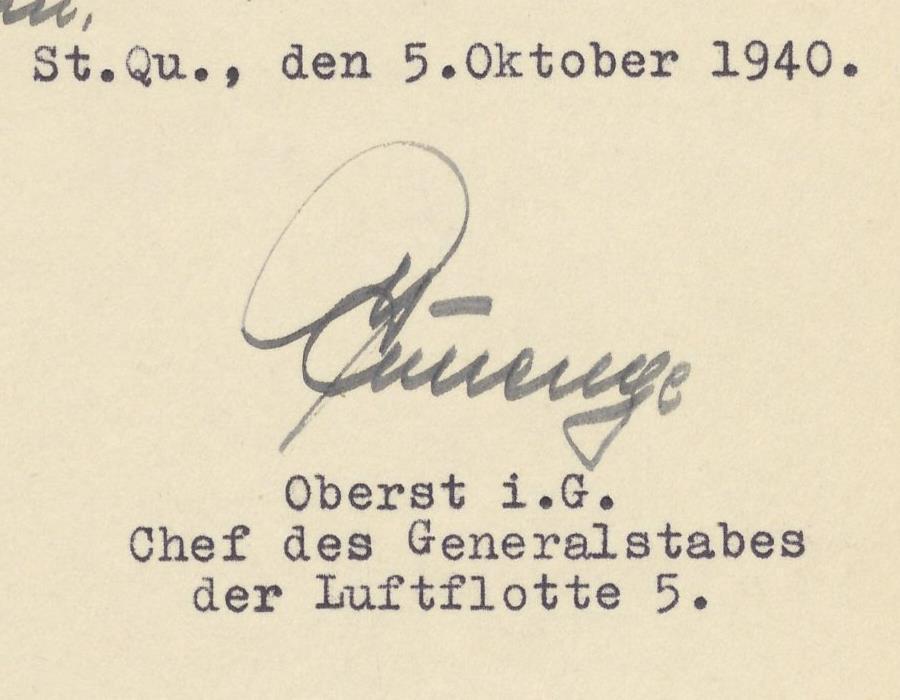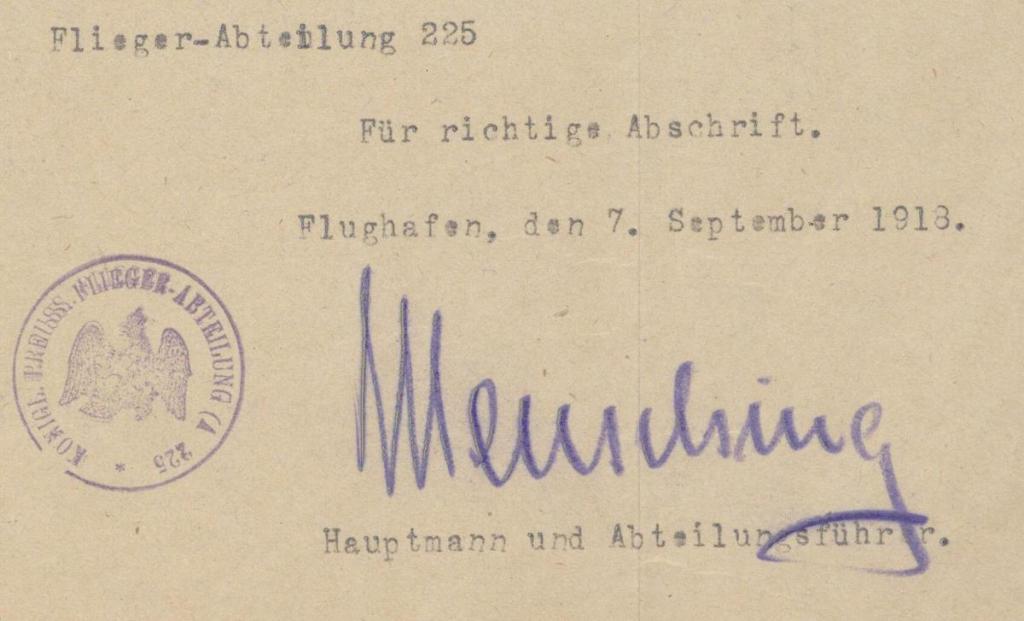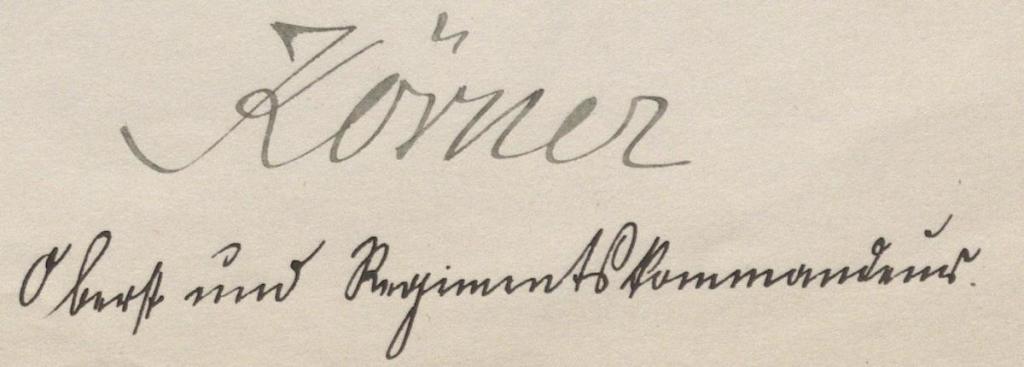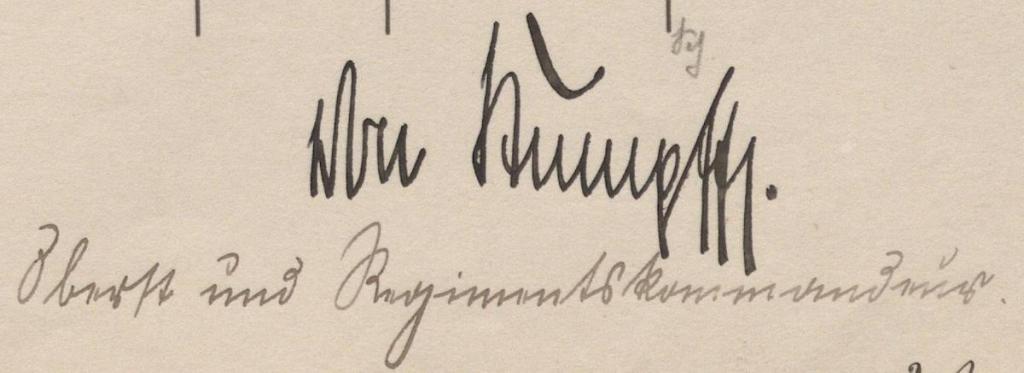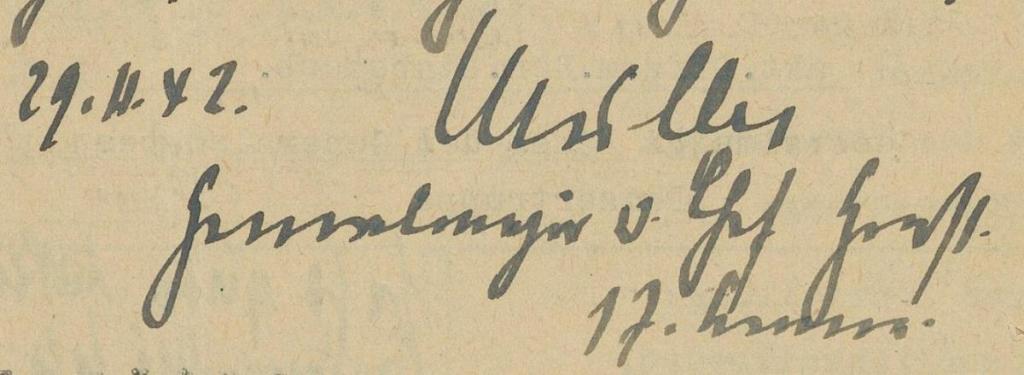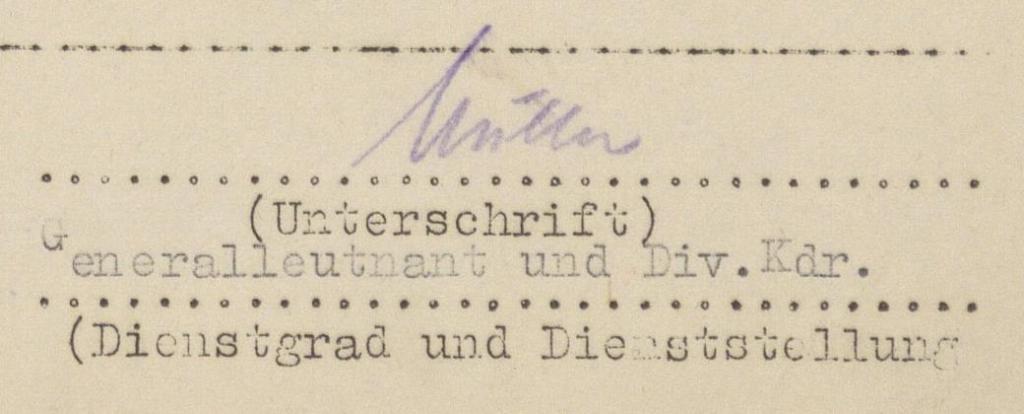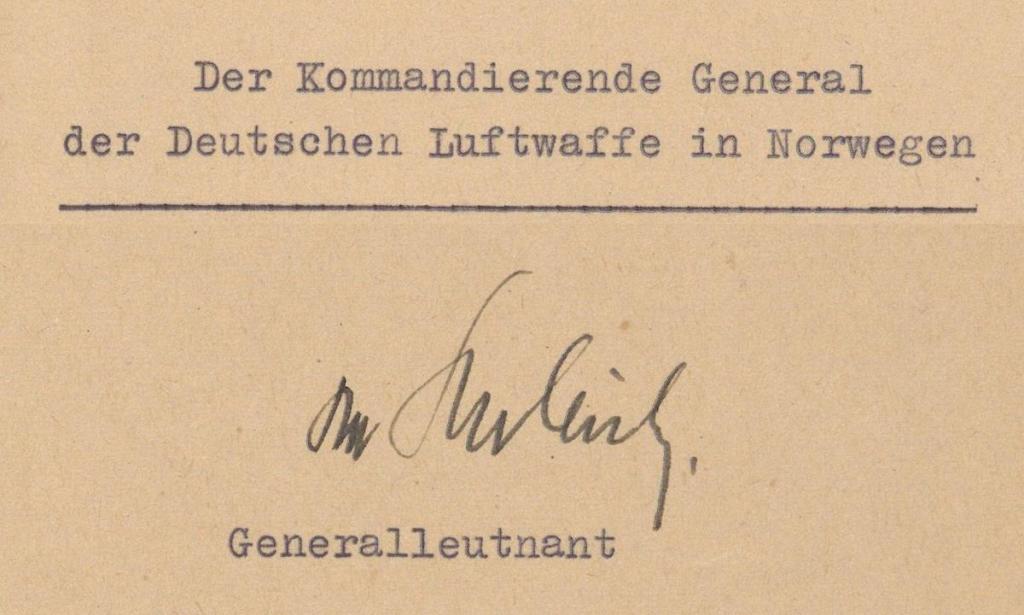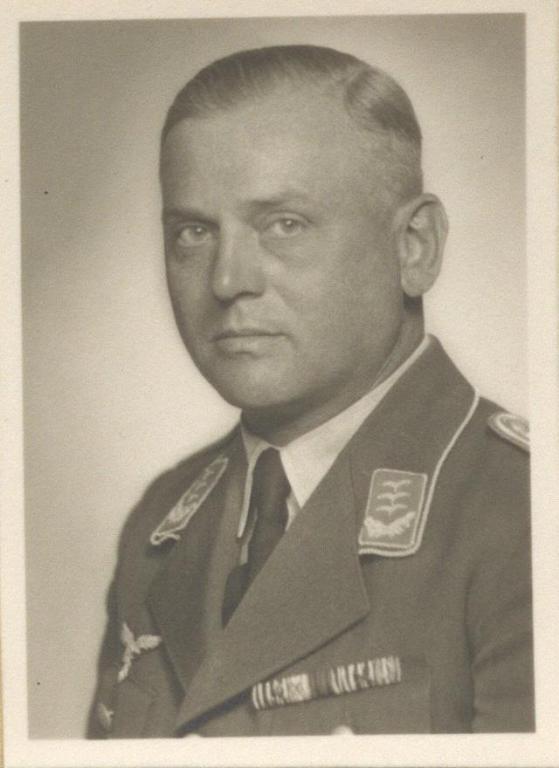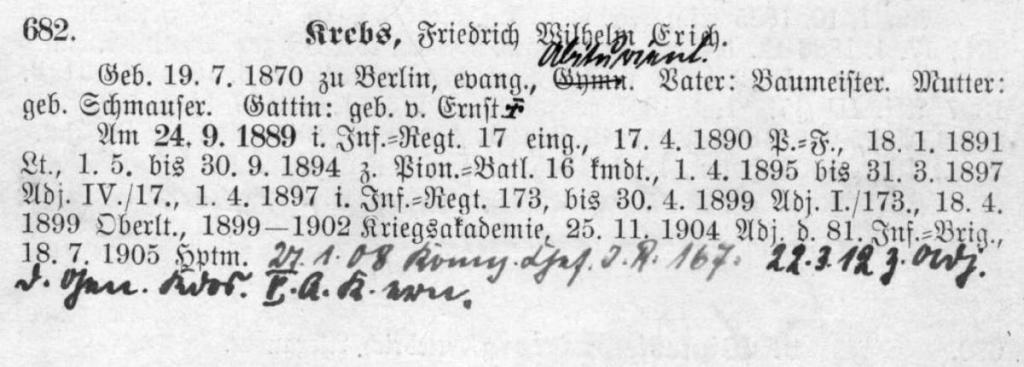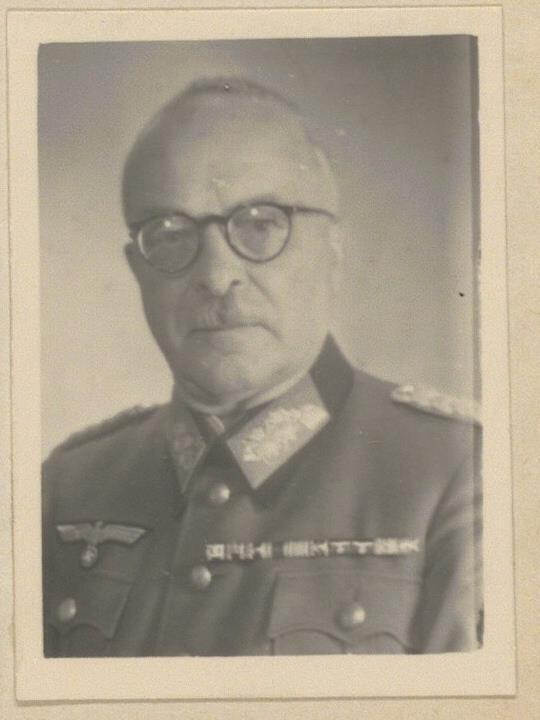-
Posts
4,908 -
Joined
-
Last visited
-
Days Won
97
Content Type
Profiles
Forums
Blogs
Gallery
Events
Store
Everything posted by Dave Danner
-
Hemmer, Hans (ab 1915 "Ritter von") * 18. Juni 1869 in München † 15. Dezember 1931 Highest rank reached: Generalmajor 28.12.1914 Chef des Generastabes des Königlich Bayerischen II. Reservekorps 08.07.1915 Chef des Generastabes der Kaiserlichen Deutschen Südarmee 04.02.1918 Chef des Generastabes des Armee-Oberkommandos 19 Ritter des Ordens "Pour le Mérite" (PLM) Ritter des Kgl. Bayerischen Militär-Max-Joseph-Ordens (BMJ3) - 9.4.1915 Komtur des Kgl. Bayerischen Militär-Max-Joseph-Ordens (BMJ2) - 4.6.1916
-
Hofacker, Eberhard von * 25. Juni 1861 in Hemmingen † 19. Januar 1928 in Tübingen Father of Dr. Cäsar von Hofacker Highest rank reached: Generalleutnant 18.05.1908 Kommandeur des Ulanen-Regiments Nr. 20 25.07.1910 Chef des Generalstabes des XVIII. Armeekorps 01.10.1913 Kommandeur der 45. Kavallerie-Brigade 20.11.1914 Kommandeur der 11. Reserve-Infanterie-Brigade 04.02.1915 Kommandeur der 4. Landwehr-Division 14.12.1915 Kommandeur der 5. Kavallerie-Division 13.08.1916 Kommandeur der 82. Reserve-Division 21.12.1916 Kommandeur der 22. Reserve-Division 05.01.1917 Kommandeur der 26. Infanterie-Division 28.10.1917 vertretungsweise Führer des Generalkommandos z.b.V. 51 03.11.1917 Führer des Generalkommandos z.b.V. 51 23.08.1918 zur Verfügung des Kgl. Württembergischen Kriegsministeriums gestellt Ritter des Ordens "Pour le Mérite" mit Eichenlaub (PLM EL) Ritterkreuz des. Kgl. Württembergischen Militär-Verdienst-Ordens (WM3) Photo from the Baden-Württemberg Landesarchiv:
-
Bassenge, Gerhard Wilhelm Julius * 18. November 1897 in Ettlingen † 13. März 1977 in Lübeck Highest rank reached: Generalmajor Chef des Generalstabes des Luftgau-Kommandos XVII Chef des Generalstabes Luftflotte 2 Chef des Generalstabes Luftflotte 5 Chef des Generalstabes der Deutschen Luftwaffenmission in Rumänien Kommandeur der 19. Luftwaffen-Felddivision Kommandant des Festungsbezirks Tunis-Bizerte Deutsches Kreuz in Gold (DKiG) - 27.7.1942 https://de.wikipedia.org/wiki/Gerhard_Bassenge https://en.wikipedia.org/wiki/Gerhard_Bassenge Examples posted a while back by tyanacek in another thread:
-
Putzier, Richard Bernhard Walter * 25. Februar 1890 in Zarnekow, Grimmen in Pommern † 17. Juli 1979 in Hamburg Highest rank reached: General der Flieger Kommodore des Kampfgeschwaders 154 „Boelcke“ Kommodore des Kampfgeschwaders 157 „Boelcke“ (Umbenennung) Kommandeur der 3. Flieger-Division General z.b.V. bei der Luftflotte 4 General z.b.V. bei der Luftflotte 2 Führer des Fliegerkorps z.b.V. 2 mit der Führung der 7. Flieger-Division (Fallschirmjäger) beauftragt Kommandeur des Luftgau-Kommandos I Kommandierenden General des Feldluftgau-Kommandos XXVI Kommandeur des Verbindungsstabes West des OKL Bevollmächtigter des Führers für Kfz-Einsatz und Erfassung im OKW Deutsches Kreuz in Silber (DKiS) - 20.3.1944 https://de.wikipedia.org/wiki/Richard_Putzier
-

luftwaffe Mensching, Karl-Albrecht
Dave Danner posted a topic in Germany: All Eras: Signature Database
Mensching, Karl-Albrecht * 18. Dezember 1888 in Isenhagen, Lüneburg † 10. Juli 1966 in Köln Highest rank reached: Generalleutnant Kommandeur des Flieger-Ausbildungsregiments 2 Kommandeur des Flieger-Ausbildungsregiments 12 Leiter des Luftkreis-Kommandos, Abteilung für Spezielle Aufgaben Nr. 20 Leiter des Luftflottenkommandos Holland Leiter des Luftflottenkommandos Norwegen Nachschubleiter der Luftflotte 5 Kommandeur des Flughafenbereichs-Kommandos 24/III Deutsches Kreuz in Silber (DKiS) https://de.wikipedia.org/wiki/Karl-Albrecht_Mensching The second signature on the second example below is Polizei-Oberst Benno Petri (1875-), who was a Generalstabsoffizier in World War I. I don't know enough about him or his assignments to determine if he should get his own signature thread. -

imperial 1914-1918 Körner, Theodor
Dave Danner posted a topic in Germany: All Eras: Signature Database
Körner, Theodor * 23. September 1863 † 21. Februar 1924 in Bad Pyrmont Father of Heer Oberst Theodor Körner Highest rank reached: Generalmajor 01.10.1912 Kommandeur des Feldartillerie-Regiments Nr. 5 15.09.1914 Kommandeur der 21. Feldartillerie-Brigade 02.03.1915 Kommandeur der 52. Feldartillerie-Brigade 15.11.1916 Kommandeur der 30. Feldartillerie-Brigade 17.03.1917 Kommandeur der 80. Reserve-Division -

imperial 1914-1918 Stumpff, Karl von
Dave Danner replied to Dave Danner's topic in Germany: All Eras: Signature Database
-

Imperial 1914-1918 Havenstein, Otto
Dave Danner replied to Dave Danner's topic in Germany: All Eras: Signature Database
-
Müller, Vincenz * 5. November 1894 in Aichach, Oberbayern † 12. Mai 1961 in Ost-Berlin Highest rank reached: Generalleutnant (Heer) / Generalleutnant der Nationalen Volksarmee https://de.wikipedia.org/wiki/Vincenz_Müller https://en.wikipedia.org/wiki/Vincenz_Müller Ritterkreuz des Eisernen Kreuzes (RK) - 7.4.1944 Deutsches Kreuz in Gold (DKiG) - 26.1.1942 Vaterländischer Verdienstorden der DDR in Gold
-
Müller, Kurt * 29. April 1882 in Ohlau, Schlesien † 4. Oktober 1942 in Wiesbaden Highest rank reached: Generalleutnant z.V. 1929-1931 Kommandeur des 5. Pionier-Bataillons 1934-1937 Inspekteur der Westbefestigungen 1939-1940 Offizier z.b.V. beim Luftgaustab XII/XIII 1940 im Stabe des Luftgau-Kommandos Westfrankreich 1941-1942 Kommandeur der 286. Sicherungs-Division https://de.wikipedia.org/wiki/Kurt_Müller_(General) https://www.lexikon-der-wehrmacht.de/Personenregister/M/MuellerKurt-R.htm
-

luftwaffe Schleich, Eduard Ritter von
Dave Danner posted a topic in Germany: All Eras: Signature Database
Schleich, Eduard Maria Joseph, ab 1918 "Ritter von" *9. August 1888 in München †15. November 1947 in Dießen am Ammersee https://en.wikipedia.org/wiki/Eduard_Ritter_von_Schleich https://de.wikipedia.org/wiki/Eduard_von_Schleich Highest rank reached: Generalleutnant Orden "Pour le Mérite" Königlich Bayerischer Militär-Max-Joseph-Orden, Ritterkreuz -
Kieckhoefer, Ernst Adolph Walter Karl *20.3.1887 in Würtemberg, Oels He served in IR 140 from 1906 to 1913, when he was transferred to the Schutztruppe. He was shot in the head on 9.9.1914 and was a British POW from then until 25.11.16 when he was exchanged. He served in the Kommando der Schutztruppen im Reichskolonialamt in 1917, and was transferred to IR 51 in January 1918. He was carried over into the Reichswehr, serving as Adjutant of the Kommandantur Neuhammer and in the 8.IR until his discharge in 1930. He was then an L-Angestellter (Kreisleiter im Kreis Brandenburg Stadt) from 1930-1933. 01.10.1933 beim Infanterie-Führer III in das L-Offizierkorps übernommen 01.05.1934 Adjutant des Bezirks-Kommandos Potsdam I 01.08.1936 Kommandeur des Wehrbezirks-Kommandos Korbach 03.11.1938 Kommandeur des Wehrbezirks-Kommandos Gotha 28.12.1939 Kommandant des Stalags Ziegenhain 10.01.1940 im Luftwaffen-Lazarett Gotha (bis 19.03.1940) 20.03.1940 Führerreserve Wehrkreis IX 15.05.1940 Kommandeur des Wehrbezirks-Kommandos Gotha 28.05.1940 Kommandant des Truppenübungsplatzes Neuhammer 31.12.1942 Führerreserve OKH 15.01.1943 Kommandant des Truppenübungsplatzes La Valdahon 03.09.1944 Führerreserve OKH 26.11.1944 Kommandeur des Wehrbezirks-Kommandos Hersfeld 16.08.1907 Leutnant 27.01.1915 Oberleutnant 25.11.1916 Hauptmann 01.02.1930 Major 01.10.1933 Major a.D. mit RDA vom 01.02.1930 05.03.1935 Major (E) 01.11.1936 Ordnungsnummer (20) zum RDA vom 01.02.1930 erhalten 01.03.1937 Oberstleutnant (E) (11) 01.11.1940 Oberst (E) (9) 01.06.1941 Oberst mit RDA vom 01.11.1940 (43)
-
Supplemental information on Dewies: 26.10.1938 in die Luftwaffe eingetreten 01.04.1939 Hauptmann (E) (RDA 1.12.33) 01.04.1940 Major 01.11.1942 Oberstleutnant 27.04.1915 1914 Eisernes Kreuz 2. Klasse 10.11.1916 1914 Eisernes Kreuz 1. Klasse 19.06.1917 Kgl Sächs. Albrechts-Orden, Ritterkreuz 2. Klasse mit Schwertern 05.11.1917 Hamburgisches Hanseatenkreuz xx.xx.191x K.u.k. Österreich-Ungarisches Militärverdienstkreuz 3. Klasse mit der Kriegsdekoration 3. Klasse xx.xx.1918 Verwundetenabzeichen in schwarz 22.08.1918 Kgl. Preuß. Hausorden von Hohenzollern, Ritterkreuz mit Schwertern No other decorations are listed in his Lebenslauf nor his Kriegsrangliste-Auszüge other than the Ehrenkreuz für Frontkämpfer and two 1920s unofficial commemoratives - the Deutsche Ehrendenkmünze and the Ritterkreuz der Deutschen Ehrenlegion. However, the photo below appears to show another ribbon, though the folding of the ribbons and the color-shifting of the black-and-white photos make it hard to tell what it is. He would have also had a Luftwaffe 4-year Dienstauszeichnung, but there's nothing further in the file on any WW2 decorations.
-
The short bios at the top are good since they generally include the other awards the SHgM recipient got. The text is mostly accounts of what the medal was awarded for, commonly written by the recipient himself. It is in these respects better than any reference on award recipients I've seen, including the Ehrenbuch for the St. Henry Order, which only has short descriptions of what the order was awarded for and does not list other decorations.
-
The three icons are Prussian decorations. The first icon is the Roter-Adlerorden 2. Klasse mit Eichenlaube. The second is the Kronenorden 3. Klasse. The third is the Dienstauszeichnungskreuz für Offiziere. AB3a - Herzoglich Anhaltischer Orden Albrechts des Bären, Ritterzeichen 1. Klasse HP2a - Großherzoglich Hessischer Verdienstorden Philipps des Großmütigen, Komturkreuz mit Stern MG2a - Großherzoglich Mecklenburgischer Greifenorden, Komturkreuz mit Stern HSH2b - Herzoglich Sachsen-Ernestinischer Hausorden, Komturkreuz WF3a - Königlich Württembergischer Friedrichs-Orden, Ritterkreuz 1. Klasse JK4 - Königlich Italienischer Orden der Krone von Italien, Offizierkreuz (Ordine della Corona d'Italia, Ufficiale)
-
Then I do not understand your question. That Wikipedia article only mentions unit awards, not individual awards. Of course, German soldiers received individual awards. They were nominated by their commanders, usually company, battalion and regimental commanders, and the awards were approved at a higher level. The authority to award the Iron Cross was given to senior commanders, but other awards usually had to be reviewed and approved by the Orders Chancery of the various German states.
-
Ernst Jüngling's Generalskartei photo shows at least one unknown decoration, but the picture is fuzzy. He does not appear to have a regular personnel file in the archives, since he was released from the army in 1944. He received the Spange to the EK2 on 4.10.1939), the Spange to the EK1 on 22.6.1940 and the KVK1X on 1.9.1943. The ribbon bar appears to be EK2Sp-HOH3X-KVK2X-???-ÖM3K-FEK-WHDA1&3, and then probably the Austrian and Hungarian (or maybe Bulgarian) Kriegserinnerungsmedaillen.


